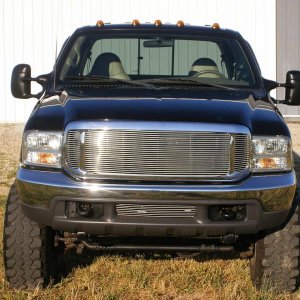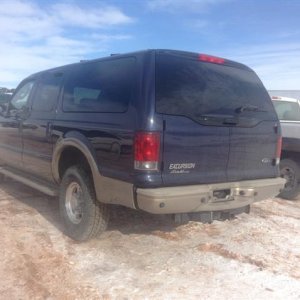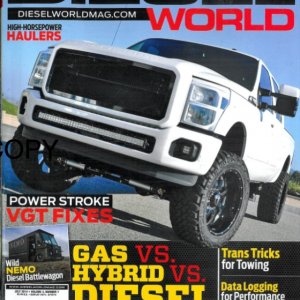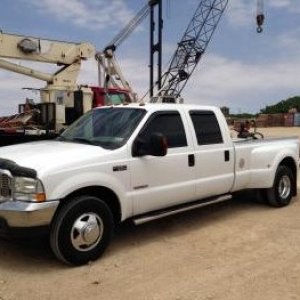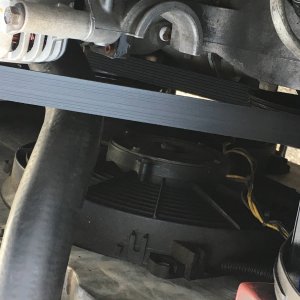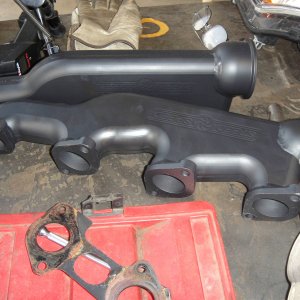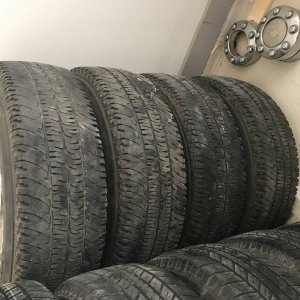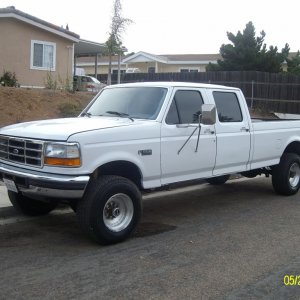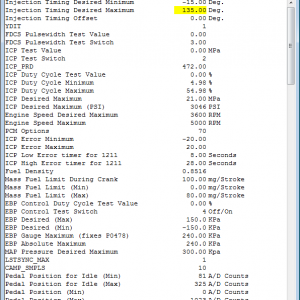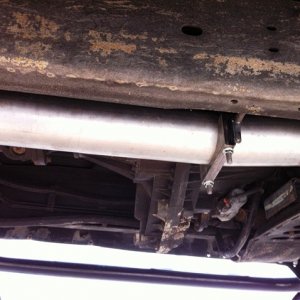rsr911
New member
First some acronyms
WMO: waste motor oil
WATF: waste transmission fluid
RUG: regular unleaded gasoline
D2: pump diesel
W85: approximately 85% WMO to 15% RUG blend. Some users add 15% RUG to the WMO
such as 40 gallons WMO and 6 gallons RUG which is actually 87/13 or others
calculate by dividing the WMO amount by 0.85 to determine how much RUG to add
such as 40/0.85=47 so they add 7 gallons RUG for a 85/15 batch
Some other definitions:
Whole house water filter: This is a 10" cartridge filter housing available at
most hardware stores.
String wound filter: these are typically 10" cartridges that fit the above
housing. They are available at commercial supply houses such as McMaster-Carr
or Grainger Industrial Supply or elsewhere online. String wound cartridges are
nominal rated meaning they don't get all particles above their rating out.
Typically when using these several passes are made or the oil is recirculated
through them.
Absolute rated filter: These filters get about 99.9 percent of particles larger
than their rating out. They are more costly and normally have a lower flow rate
so they are normally used at the end of the process
Upflow processor: A 55 gallon drum set up to separate water and heavy
particulate from the WMO. Most include a drain valve in the bottom, typically a
pipe welded into the bottom side of the drum with a valve. The top of the drum
is sealed. The small bung has an 3/4" NPT elbow installed, then a ball valve and
a filter housing typically containing a 20 {10} micron string wound filter. The
output of the filter has a hose barb and normally a 3/8" hose. This would lead
to a mixing drum. The larger bung has a 2" close pipe nipple. Inside this nipple
a length of 2" exhaust pipe is welded that extends down to about 6-8" from the
bottom of the drum when the nipple is threaded in. Next the top third of a
closed head drum is cut off and flipped over then threaded onto the 2" pipe
nipple forming a sort of funnel. {now using and inverted 55 gallon drum} This will hold about 20 gallons of oil. Here is
how the process works: First the barrel needs to be completely filled through
the funnel and all the air let out through the 3/4" ball valve then it should
sit at least 1-2 weeks. To operate the system fill the funnel with 20 {55}gallons of
oil. Open the valve slightly until a very light drizzle of oil comes out of the
3/8" hose. Ideally it will take about a day and a half for all the oil to empty
out of the funnel. The flow slows down as the funnel empties. Since I make 40 +
7 gallon batches I continue adding my other 20 gallons of WMO as the funnel
empties. Once all the oil has emptied from the funnel into the drum and forced
clean dry oil out through the filter you may close the valve until the next time
you need to process oil. Periodically {every mix} you should open the bottom drain and draw
off any water and sludge that is present, failure to do this will eventually
result in a barrel full of water and sludge.
Mixing barrel: There are several ways to do this. If you can weld I have found
the nicest setup to be a 3/4" pipe welded into the bottom side of the barrel
about 1/2" up from the bottom. Put a 3/4" ball valve on the pipe then a few
elbows and a 12-15" length of pipe to bring the pipe high enough to screw on a
filter housing. I have two {three} filter housings in series each with a 5 {1} micron string
wound filter. After the filters I attach my mixing pump. Mine is a gear pump
that is geared down to do about 3 gallons per minute (gpm) which is the max
rating of my string wound filters. If your pump will not pull through the
filters then you may try pushing instead, just be careful not to create too much
pressure especially if your pump is large. You want to either filter in a vacuum
(pulling) or under very little pressure so the filters catch as much particulate
as possible. Too much pressure will force particulate past the filters. The
output of my pump has a tee fitting with a valve on each side. One side goes
back into the mix barrel. The idea is to recirculate and mix the oil. My method
is to add my RUG to the barrel first then let my upflow drizzle in 40 {47.5} gallons
over a couple of days. Once this is complete I stir with a wooden paddle then
turn on my pump for about 3 {1-2} hours. In three hours roughly 180 gallons of mix has
gone through my filters. After recirculating I close the valve that goes back
into the drum and open the valve on the other side of the tee fitting. This
leads to a 5 micron absolute rated cartridge { replaced 5 micron absolute with drmiller100's larger filter then a large 3 micron 99% efficient spin on fuel filter, these are both on the pressure side.}. I pump through this either into
storage or into my truck.
drmiller100 has a different "low buck" method that I will do my best to describe
here: He uses just a mixing drum, adds his WMO and RUG and mixes it up then lets
it settle for a day to two. He then uses a pump to pull the crud and water off
the bottom of his mix barrel. Next using a small diaphragm pump he recirculates
through two 5 micron cartridges and then through a spin on absolute rated fuel
filter and into his truck or storage.
I don't think either system is better than the other as both drmiller100 and
myself have had good luck with our respective systems. I will only say that with
the pre-settling and upflow processor I have never had an issue with water in my
fuel. My recommendation to novices using drmiller100's setup would be to add a
water block or water separator filter inline as a precaution.
Another method is to use a centrifuge such as a Dieselcraft. I won't get into
the details here but suffice it to say that centrifuging is essentially forced
settling using the g-force created by the spinning centrifuge bowl. I prefer the
cheap and easy method of just regular settling and filtering.
Here are some ideas I've found helpful. I like to pre-settle my oil for at least
a month before processing. What I did originally was weld some 3/4" pipes into
the bottom sides of 3 55 gallon closed top barrels. I put my collected oil in
these barrels and date them with marker on masking tape. Since my processing has
grown I now use a 275 gallon fuel oil tank for storage and pre-settling. I
always draw off the top of the settling barrels. {I now add 10% RUG to all incoming WMO then add to the tank so my oil is all 10%, I add the last 5% in my mix tank before filtering }On my tank I put a tap at the
55 gallon mark and draw from there. From time to time open the bottom valves on
the barrels to drain off any water and sludge you may find. I have found that
letting the oil settle this long really gets a lot of the junk out prior to
upflow processing and filtering. Another thing some of us have found is that
after mixing the RUG and WMO together if we let the mix sit for a day or two the
RUG causes more sludge to drop out of suspension. That is one of the reasons I
start with RUG in my mix barrel and then let the upflow slowly fill it. It is
also important to carry spare fuel filters, the tools to change them, and about
a quart of fuel with you, especially at first. We believe that something in the
oil cleans the inside of the tanks and fuel systems because normally when first
starting out you will plug 1-3 filters in the first 500 miles or less. Once the
crud is out of the tanks the onboard filters seem to last a rather long time but
it is still good practice to carry a spare filter and some fuel to fill it.
Many of us are running the W85 blend but consider this a starting point. A lot
depends upon the oil you collect, thicker oil will require more RUG to thin it
out while thin oils like WATF require less, sometimes as little as 10% RUG. I
have found that my W85 starts and runs well down to about 10F, below that I have
added about 10% D2 to thin it a little more but next winter I'll likely just add
5% RUG instead since I did try that successfully in the past few weeks.
I feel I must strongly urge anyone interested in getting into any alternative
fuel to get to know their vehicle on D2 for at least a month or two before
experimenting with alternative fuels. Also make sure everything is in working
order. There are several reasons for this. Mainly the naysayers will almost
always blame your fuel choice if your vehicle breaks down. The second big reason
is you want to know how your vehicle should start cold and drive on D2 so that
you can properly adjust your fuel. Properly blended WMO is indistinquishble from
D2 other than slightly quieter running (less diesel knock). Another
recommendation is to install a dash mounted pressure gauge after the fuel
filter. On amy IDI I just used a 15psi boost gauge and some nylon gauge tubing.
This lets me closely monitor my filter condition as well as how well my blend is
flowing at low temps so I can adjust accordingly. I find the first sign that the
filter is clogging is if the pressure drops a little during hard acceleration,
like 1-2 psi on the IDI. My truck drops 1/2 psi under hard acceleration with a
fresh filter regardless of fuel or temperature so that is my baseline. If you
are running an engine equipped with a Stanadyne DB2 injection pump DO NOT let
the pressure drop below 4psi, this will eventually kill the transfer pump
section of the pump because it will cause it to cavitate. This is why I highly
recommend the pressure gauge for the IDI trucks.
Well there it is, just about everything I know about running WMO in my vehicle
as well as what I have learned from others. Hopefully some of the other forum
members will chime in with some stuff I may have missed.
Updates are in {updates}
WMO: waste motor oil
WATF: waste transmission fluid
RUG: regular unleaded gasoline
D2: pump diesel
W85: approximately 85% WMO to 15% RUG blend. Some users add 15% RUG to the WMO
such as 40 gallons WMO and 6 gallons RUG which is actually 87/13 or others
calculate by dividing the WMO amount by 0.85 to determine how much RUG to add
such as 40/0.85=47 so they add 7 gallons RUG for a 85/15 batch
Some other definitions:
Whole house water filter: This is a 10" cartridge filter housing available at
most hardware stores.
String wound filter: these are typically 10" cartridges that fit the above
housing. They are available at commercial supply houses such as McMaster-Carr
or Grainger Industrial Supply or elsewhere online. String wound cartridges are
nominal rated meaning they don't get all particles above their rating out.
Typically when using these several passes are made or the oil is recirculated
through them.
Absolute rated filter: These filters get about 99.9 percent of particles larger
than their rating out. They are more costly and normally have a lower flow rate
so they are normally used at the end of the process
Upflow processor: A 55 gallon drum set up to separate water and heavy
particulate from the WMO. Most include a drain valve in the bottom, typically a
pipe welded into the bottom side of the drum with a valve. The top of the drum
is sealed. The small bung has an 3/4" NPT elbow installed, then a ball valve and
a filter housing typically containing a 20 {10} micron string wound filter. The
output of the filter has a hose barb and normally a 3/8" hose. This would lead
to a mixing drum. The larger bung has a 2" close pipe nipple. Inside this nipple
a length of 2" exhaust pipe is welded that extends down to about 6-8" from the
bottom of the drum when the nipple is threaded in. Next the top third of a
closed head drum is cut off and flipped over then threaded onto the 2" pipe
nipple forming a sort of funnel. {now using and inverted 55 gallon drum} This will hold about 20 gallons of oil. Here is
how the process works: First the barrel needs to be completely filled through
the funnel and all the air let out through the 3/4" ball valve then it should
sit at least 1-2 weeks. To operate the system fill the funnel with 20 {55}gallons of
oil. Open the valve slightly until a very light drizzle of oil comes out of the
3/8" hose. Ideally it will take about a day and a half for all the oil to empty
out of the funnel. The flow slows down as the funnel empties. Since I make 40 +
7 gallon batches I continue adding my other 20 gallons of WMO as the funnel
empties. Once all the oil has emptied from the funnel into the drum and forced
clean dry oil out through the filter you may close the valve until the next time
you need to process oil. Periodically {every mix} you should open the bottom drain and draw
off any water and sludge that is present, failure to do this will eventually
result in a barrel full of water and sludge.
Mixing barrel: There are several ways to do this. If you can weld I have found
the nicest setup to be a 3/4" pipe welded into the bottom side of the barrel
about 1/2" up from the bottom. Put a 3/4" ball valve on the pipe then a few
elbows and a 12-15" length of pipe to bring the pipe high enough to screw on a
filter housing. I have two {three} filter housings in series each with a 5 {1} micron string
wound filter. After the filters I attach my mixing pump. Mine is a gear pump
that is geared down to do about 3 gallons per minute (gpm) which is the max
rating of my string wound filters. If your pump will not pull through the
filters then you may try pushing instead, just be careful not to create too much
pressure especially if your pump is large. You want to either filter in a vacuum
(pulling) or under very little pressure so the filters catch as much particulate
as possible. Too much pressure will force particulate past the filters. The
output of my pump has a tee fitting with a valve on each side. One side goes
back into the mix barrel. The idea is to recirculate and mix the oil. My method
is to add my RUG to the barrel first then let my upflow drizzle in 40 {47.5} gallons
over a couple of days. Once this is complete I stir with a wooden paddle then
turn on my pump for about 3 {1-2} hours. In three hours roughly 180 gallons of mix has
gone through my filters. After recirculating I close the valve that goes back
into the drum and open the valve on the other side of the tee fitting. This
leads to a 5 micron absolute rated cartridge { replaced 5 micron absolute with drmiller100's larger filter then a large 3 micron 99% efficient spin on fuel filter, these are both on the pressure side.}. I pump through this either into
storage or into my truck.
drmiller100 has a different "low buck" method that I will do my best to describe
here: He uses just a mixing drum, adds his WMO and RUG and mixes it up then lets
it settle for a day to two. He then uses a pump to pull the crud and water off
the bottom of his mix barrel. Next using a small diaphragm pump he recirculates
through two 5 micron cartridges and then through a spin on absolute rated fuel
filter and into his truck or storage.
I don't think either system is better than the other as both drmiller100 and
myself have had good luck with our respective systems. I will only say that with
the pre-settling and upflow processor I have never had an issue with water in my
fuel. My recommendation to novices using drmiller100's setup would be to add a
water block or water separator filter inline as a precaution.
Another method is to use a centrifuge such as a Dieselcraft. I won't get into
the details here but suffice it to say that centrifuging is essentially forced
settling using the g-force created by the spinning centrifuge bowl. I prefer the
cheap and easy method of just regular settling and filtering.
Here are some ideas I've found helpful. I like to pre-settle my oil for at least
a month before processing. What I did originally was weld some 3/4" pipes into
the bottom sides of 3 55 gallon closed top barrels. I put my collected oil in
these barrels and date them with marker on masking tape. Since my processing has
grown I now use a 275 gallon fuel oil tank for storage and pre-settling. I
always draw off the top of the settling barrels. {I now add 10% RUG to all incoming WMO then add to the tank so my oil is all 10%, I add the last 5% in my mix tank before filtering }On my tank I put a tap at the
55 gallon mark and draw from there. From time to time open the bottom valves on
the barrels to drain off any water and sludge you may find. I have found that
letting the oil settle this long really gets a lot of the junk out prior to
upflow processing and filtering. Another thing some of us have found is that
after mixing the RUG and WMO together if we let the mix sit for a day or two the
RUG causes more sludge to drop out of suspension. That is one of the reasons I
start with RUG in my mix barrel and then let the upflow slowly fill it. It is
also important to carry spare fuel filters, the tools to change them, and about
a quart of fuel with you, especially at first. We believe that something in the
oil cleans the inside of the tanks and fuel systems because normally when first
starting out you will plug 1-3 filters in the first 500 miles or less. Once the
crud is out of the tanks the onboard filters seem to last a rather long time but
it is still good practice to carry a spare filter and some fuel to fill it.
Many of us are running the W85 blend but consider this a starting point. A lot
depends upon the oil you collect, thicker oil will require more RUG to thin it
out while thin oils like WATF require less, sometimes as little as 10% RUG. I
have found that my W85 starts and runs well down to about 10F, below that I have
added about 10% D2 to thin it a little more but next winter I'll likely just add
5% RUG instead since I did try that successfully in the past few weeks.
I feel I must strongly urge anyone interested in getting into any alternative
fuel to get to know their vehicle on D2 for at least a month or two before
experimenting with alternative fuels. Also make sure everything is in working
order. There are several reasons for this. Mainly the naysayers will almost
always blame your fuel choice if your vehicle breaks down. The second big reason
is you want to know how your vehicle should start cold and drive on D2 so that
you can properly adjust your fuel. Properly blended WMO is indistinquishble from
D2 other than slightly quieter running (less diesel knock). Another
recommendation is to install a dash mounted pressure gauge after the fuel
filter. On amy IDI I just used a 15psi boost gauge and some nylon gauge tubing.
This lets me closely monitor my filter condition as well as how well my blend is
flowing at low temps so I can adjust accordingly. I find the first sign that the
filter is clogging is if the pressure drops a little during hard acceleration,
like 1-2 psi on the IDI. My truck drops 1/2 psi under hard acceleration with a
fresh filter regardless of fuel or temperature so that is my baseline. If you
are running an engine equipped with a Stanadyne DB2 injection pump DO NOT let
the pressure drop below 4psi, this will eventually kill the transfer pump
section of the pump because it will cause it to cavitate. This is why I highly
recommend the pressure gauge for the IDI trucks.
Well there it is, just about everything I know about running WMO in my vehicle
as well as what I have learned from others. Hopefully some of the other forum
members will chime in with some stuff I may have missed.
Updates are in {updates}
Last edited:

